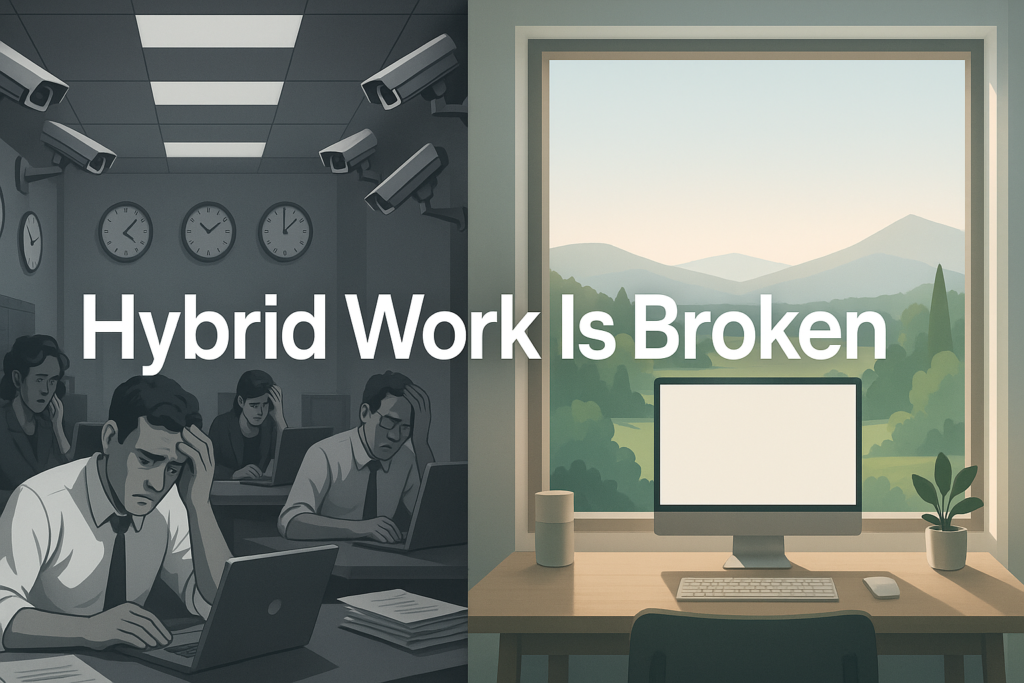
Most companies claiming to be “hybrid” aren’t blending the best of remote and in-office. They’re doing office cosplay with extra steps.
Hybrid work done wrong is worse than being fully remote or fully onsite. Why? Because it creates confusion, mixed signals, and performative policies that satisfy no one. You’re told to enjoy flexibility but still have to commute for meetings that could’ve been Slack threads.
And the worst part? Companies think it’s progressive.
The Illusion of Hybrid Freedom
Let’s call it what it is: a lot of hybrid setups are just old-school management wrapped in new buzzwords.
- “Come to the office twice a week.” Why? Just because.
- “You’re remote, but we need you online 9 to 5.” Then it’s not remote.
- “Work wherever, but let us know your exact location.” For what purpose?
Hybrid becomes theater when location is prioritized over output.
And it’s not about collaboration. It’s about control.
When Hybrid Actually Works: Your System Isn’t the Problem
Take a real example. Some teams (like ours) allow flexibility by design, not by exception:
- If a task is estimated at six hours and someone finishes it in four, they’re not punished with filler work.
- No one’s forced to stay logged in, frozen at their desk, to prove presence.
- As long as you’re reachable and deliver, no one’s asking where you are or whether you used your time “properly.”
We use Slack—but only for work. Phones help with availability, not surveillance. And after hours? Slack stays closed. We don’t blur the lines between colleague and friend just to feel “agile.”
That’s what respect looks like in a hybrid system. Not surveillance. Not guilt. Just clarity.
Why Most Hybrid Policies Fail
Because they don’t trust people to self-manage.
Instead of clear deliverables, they rely on visibility. Instead of defined goals, they expect butts in chairs. And instead of empowering teams to own their schedules, they enforce them under the illusion of flexibility.
You can’t say “flexible” and penalize people for taking breaks between tasks. You can’t praise “asynchronous work” and still demand morning huddles for every timezone.
It’s contradictory. And people notice.
The Ripple Effect No One Admits
When remote work surged during the pandemic, it wasn’t because companies evolved—it was because they were forced. Many weren’t ready. And that opened the door to both freedom and abuse.
Yes, some people got lazy. Others gamed the system. A few bad apples took on extra jobs, hid behind green dots, or vanished into the ether. But they were the 0.1%—not the norm.
The ripple? More monitoring. More suspicion. More rules that made life harder for the 99.9% who were actually doing the work.
Now, for many, remote work feels more restrictive than being onsite. The promise of flexibility is buried under approvals, status checks, and “just checking in” messages.
Letting go of control isn’t reckless. It’s required. It’s how you stop punishing everyone for the mistakes of a few.
What Real Hybrid Looks Like
Real hybrid isn’t remote-lite. It’s outcome-heavy. It looks like:
- Deliverables > Location. If you hit what matters, where you work becomes irrelevant.
- Reachability, not presence. Use tools like Slack for connection, not surveillance.
- Clear expectations. Not “online at 9,” but “task X done by end of day.”
- Optional office time. Use the space if it helps. Don’t use it to score points.
Don’t treat your team like kids. And don’t treat them like friends either. Treat them like professionals—with clear goals, reachable systems, and the space to do the job without being babysat.
The Real Reason Companies Push Fake Hybrid
Because letting go of control is terrifying.
It’s easier to bring people in twice a week than to learn how to manage asynchronously. It’s easier to monitor presence than to measure output. And it’s easier to blame “remote issues” than admit your leadership structure wasn’t built for trust.
External Perspective: What the Data Shows
According to Microsoft’s 2024 Work Trend Index, poorly implemented hybrid models lead to higher stress, fragmented collaboration, and declining trust. The research shows that while workers crave flexibility, unclear systems and surveillance-style oversight create burnout—not productivity.
When hybrid policies aren’t built on purpose, they generate resistance, not results.
Internal Signal: You Already Have the Blueprint
If you’re still stuck between chaos and command, revisit our breakdown on making hybrid work without micromanagement. The foundation was already set. The problem isn’t flexibility.
It’s fear.
Final Thought
Hybrid work isn’t a compromise. It’s a design challenge. Do it right, and you get trust, output, and balance. Do it wrong, and you get two cultures clashing under one confused policy.
Most companies call their model hybrid.
Very few actually are.
